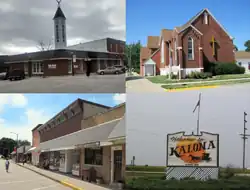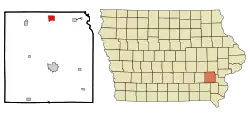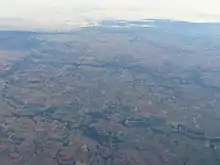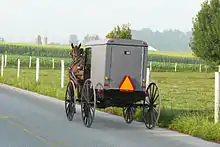Kalona, Iowa
Kalona is a city in Washington County, Iowa. It is part of the Iowa City metropolitan area. The population was 2,630 at the time of the 2020 census.[3] Kalona is the second-largest city in Washington County.[4]
Kalona, Iowa | |
|---|---|
 Left column: Downtown Kalona
Right column: Kalona United Methodist Church, Kalona Welcome Sign | |
| Nickname: Quilt Capitol of Iowa | |
 Location of Kalona, Iowa | |
| Coordinates: 41°29′15″N 91°42′07″W | |
| Country | |
| State | |
| County | Washington |
| Government | |
| • Mayor | Jimmy Donaldson |
| Area | |
| • Total | 2.15 sq mi (5.57 km2) |
| • Land | 2.15 sq mi (5.57 km2) |
| • Water | 0.00 sq mi (0.00 km2) |
| Elevation | 666 ft (203 m) |
| Population (2020) | |
| • Total | 2,630 |
| • Density | 1,220.42/sq mi (471.24/km2) |
| Time zone | UTC-6 (Central (CST)) |
| • Summer (DST) | UTC-5 (CDT) |
| ZIP code | 52247 |
| Area code | 319 |
| FIPS code | 19-40170 |
| GNIS feature ID | 2395485[2] |
| Website | www |

History
Amish settlement in what is now the Kalona area began in the 1840s, placing the Amish among the first European settlers in the area. The split between Old Order Amish and Amish Mennonites occurred in the 1860s in most places, but it was not until the 1880s that the formal split occurred in Iowa, even though a process of sorting out between conservatives and change-minded Amish had begun a decade earlier or so in Iowa.[5] Most Amish Mennonites later assimilated and lost their Amish identity. The Beachy Amish broke away from the Old Orders in the 1920s.[6]
The Burlington, Cedar Rapids and Northern Railway built a 66-mile branch from Iowa City to What Cheer via Kalona in 1879.[7][8]
Kalona was established by the railroad on August 6, 1879.[9] The name was suggested to the railroad by a Mr. Myers, who owned a bull of that name. The town remained unincorporated until 1890.[10]
Kalona is home to a burgeoning craft, antiques, and local products industry. Its proximity to both Iowa City, Iowa and a large Amish settlement have allowed growth in population and industry in recent years. The town is home to a variety of locally owned shops and restaurants. The city centers around the historic old town business section of Kalona, which features many local businesses that are popular with tourists.
Geography
According to the United States Census Bureau, the city has a total area of 2.15 square miles (5.57 km2), all of it land.[11]
Demographics
| Year | Pop. | ±% |
|---|---|---|
| 1890 | 211 | — |
| 1900 | 530 | +151.2% |
| 1910 | 466 | −12.1% |
| 1920 | 632 | +35.6% |
| 1930 | 704 | +11.4% |
| 1940 | 765 | +8.7% |
| 1950 | 947 | +23.8% |
| 1960 | 1,235 | +30.4% |
| 1970 | 1,488 | +20.5% |
| 1980 | 1,862 | +25.1% |
| 1990 | 1,942 | +4.3% |
| 2000 | 2,293 | +18.1% |
| 2010 | 2,363 | +3.1% |
| 2020 | 2,630 | +11.3% |
| Source:"U.S. Census website". United States Census Bureau. Retrieved March 29, 2020. and Iowa Data Center Source: | ||
2010 census
As of the census[13] of 2010, there were 2,363 people, 1,053 households, and 657 families living in the city. The population density was 1,158.3 inhabitants per square mile (447.2/km2). There were 1,141 housing units at an average density of 559.3 per square mile (215.9/km2). The racial makeup of the city was 97.2% White, 0.4% African American, 0.3% Native American, 0.2% Asian, 1.1% from other races, and 0.9% from two or more races. Hispanic or Latino of any race were 2.0% of the population.
There were 1,053 households, of which 26.4% had children under the age of 18 living with them, 50.1% were married couples living together, 9.5% had a female householder with no husband present, 2.8% had a male householder with no wife present, and 37.6% were non-families. 33.9% of all households were made up of individuals, and 18.4% had someone living alone who was 65 years of age or older. The average household size was 2.20 and the average family size was 2.82.
The median age in the city was 45.7 years. 21.9% of residents were under the age of 18; 5.6% were between the ages of 18 and 24; 21.5% were from 25 to 44; 28.2% were from 45 to 64; and 23% were 65 years of age or older. The gender makeup of the city was 45.5% male and 54.5% female.
2000 census
As of the census[14] of 2000, there were 2,293 people, 947 households, and 597 families living in the city. The population density was 1,119.9 inhabitants per square mile (432.4/km2). There were 986 housing units at an average density of 481.6 per square mile (185.9/km2). The racial makeup of the city was 98.08% White, 0.22% African American, 0.48% Native American, 0.39% Asian, 0.04% Pacific Islander, 0.26% from other races, and 0.52% from two or more races. Hispanic or Latino of any race were 1.09% of the population.
There were 947 households, out of which 27.2% had children under the age of 18 living with them, 55.5% were married couples living together, 6.3% had a female householder with no husband present, and 36.9% were non-families. 33.4% of all households were made up of individuals, and 16.2% had someone living alone who was 65 years of age or older. The average household size was 2.32 and the average family size was 3.00.
In the city, the population was spread out, with 23.5% under the age of 18, 7.2% from 18 to 24, 24.4% from 25 to 44, 21.1% from 45 to 64, and 23.8% who were 65 years of age or older. The median age was 41 years. For every 100 females, there were 80.7 males. For every 100 females age 18 and over, there were 74.7 males.
The median income for a household in the city was $33,750, and the median income for a family was $45,897. Males had a median income of $30,776 versus $24,974 for females. The per capita income for the city was $22,474. About 5.0% of families and 6.7% of the population were below the poverty line, including 7.6% of those under age 18 and 6.2% of those age 65 or over.
Culture

Not far from Kalona is located one of the largest Amish settlements west of the Mississippi with eleven church districts and a population of roughly 1,200 people. It is the oldest in Iowa, founded in 1846.[15] The Kalona New Order Amish affiliation is one of the most liberal concerning the use of technology, allowing even tractors for field work. Kalona is the home of the Iowa Mennonite Archives, located at the Kalona Historical Village.[16] Noah Troyer (1831–1886), one of the two "sleeping preachers" among the Amish Mennonites, lived three miles north of Kalona.[17] The Iowa Mennonite School is located a few miles northwest of Kalona.
Education
The Mid-Prairie Community School District operates local area public schools.[18]
Notable people
- Bontrager Family Singers, 12-member family of musicians who originated in and reside in Kalona[19]
References
- "2020 U.S. Gazetteer Files". United States Census Bureau. Retrieved March 16, 2022.
- U.S. Geological Survey Geographic Names Information System: Kalona, Iowa
- "2020 Census State Redistricting Data". census.gov. United states Census Bureau. Retrieved August 12, 2021.
- "About Kalona". Kalona Chamber of Commerence. Archived from the original on September 20, 2011. Retrieved September 9, 2011.
- Steven Dale Reschly: The Amish on the Iowa prairie, 1840-1910, Baltimore and London, 2000, pages 163-4.
- Dorothy, Schwieder, Tom Morain, A Peculiar People, Iowa's Old Order Amish, University of Iowa Press, 1975; page 5.
- Third Annual Report of the Board of Railroad Commissioners for the Year Ending June 30, 1880. Des Moines: Mills, 1880, p. 133.
- Travelers' Official Guide of the Railway and Steam Navigation Lines in the United States and Canada. New York: National Railway Publication Co., 1881, pp. 250-251.
- The History of Washington County, Iowa: Its Cities, Towns, Etc. Union Historical Company. 1880. p. 593.
- Tom Savage, A Dictionary of Iowa Place Names, University of Iowa Press, 2007; page 119.
- "US Gazetteer files 2010". United States Census Bureau. Archived from the original on July 2, 2012. Retrieved May 11, 2012.
- "Census of Population and Housing". Census.gov. Retrieved June 4, 2015.
- "U.S. Census website". United States Census Bureau. Retrieved May 11, 2012.
- "U.S. Census website". United States Census Bureau. Retrieved January 31, 2008.
- "Iowa Amish". Amish State Guide. Retrieved December 4, 2010.
- "Kalona Historical Village and its Museums". www.kalonaiowa.org.
- Harry H. Hiller. "The Sleeping Preacher: An Historical Study of the Role of Charisma in Amish Society". Pennsylvania Folklife, vol. 18 (Winter 1968/69), p. 12.
- "MID-PRAIRIE" (PDF). Iowa Department of Education. Retrieved September 24, 2020.
- Jennifer Borash (2008). "Mixing farming and music: Bontrager family lives out their two passions". The Dairy Star. Sauk Centre, Minnesota. Retrieved April 30, 2016.
External links
- Kalona Chamber of Commerce
- City-Data Comprehensive Statistical Data and more about Kalona